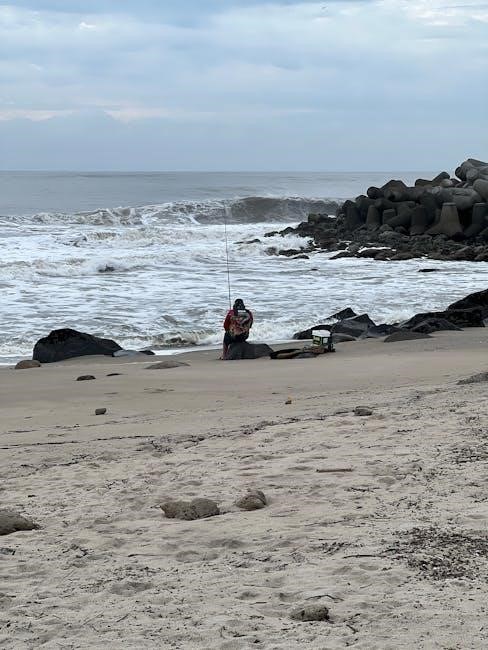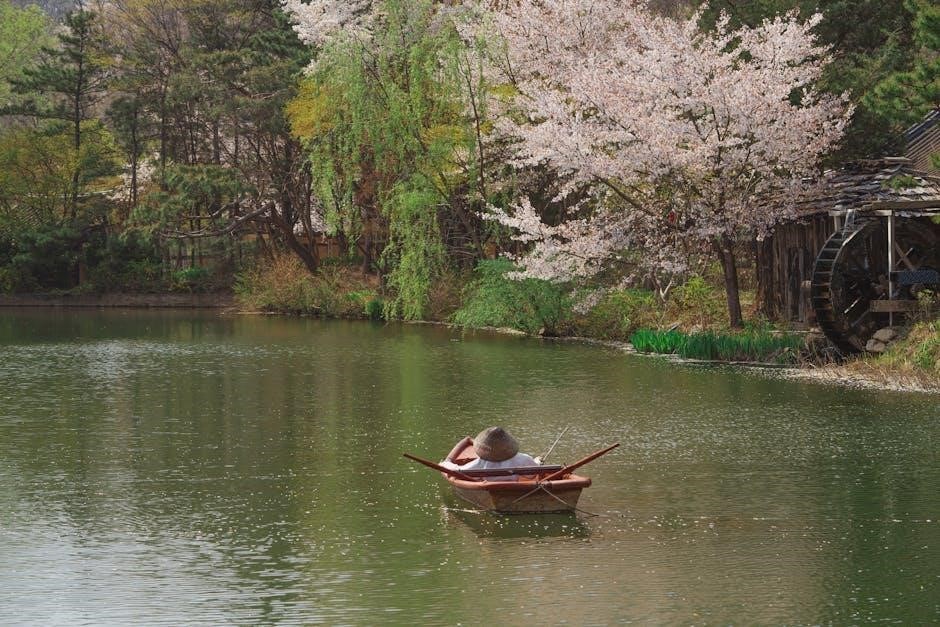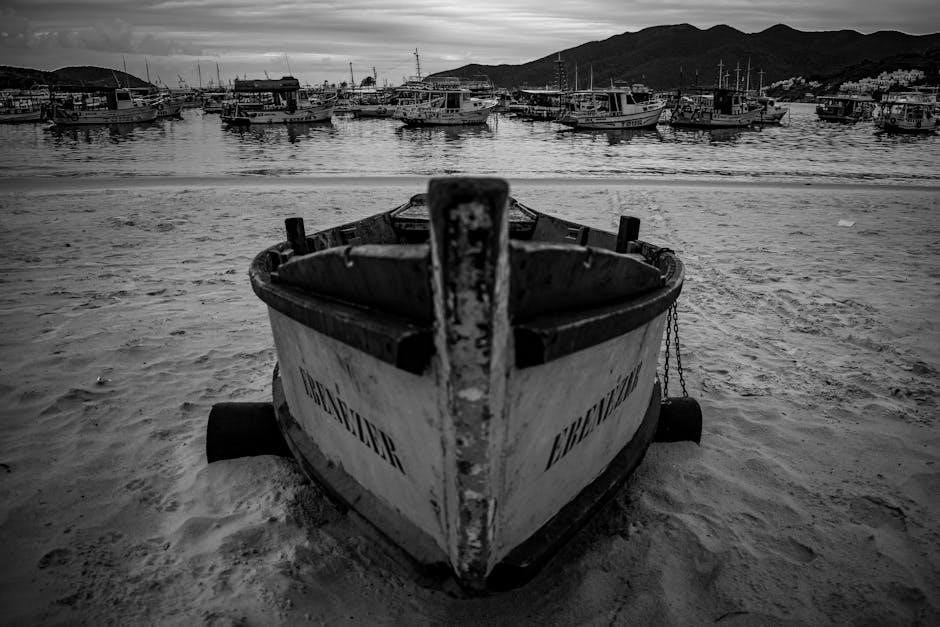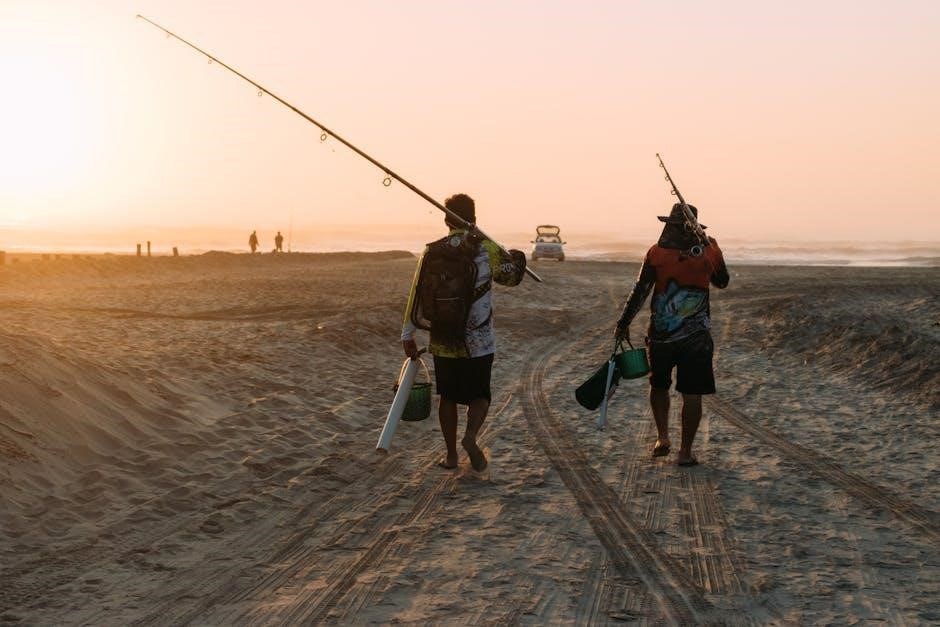how much do you tip a fishing guide

Tipping fishing guides is a customary way to express gratitude for their expertise and effort. Typically‚ tips range from 15% to 20% of the trip cost‚ reflecting the quality of service and overall experience.
Why Tipping Matters in the Fishing Industry
Tipping is vital as it reflects appreciation for the guide’s expertise and effort. It fosters long-term relationships and incentivizes exceptional service. Guides rely on tips as part of their income‚ covering expenses like gear and transportation. A fair tip ensures they can continue providing high-quality experiences‚ making it a cornerstone of the industry’s culture and a gesture of gratitude for their dedication and hard work.
Understanding the Role of Fishing Guides
Fishing guides play a crucial role in ensuring a successful and enjoyable experience on the water. They provide expert knowledge of local waters‚ techniques‚ and fish behavior‚ while also ensuring safety and navigating challenging conditions. Guides often work long hours‚ managing gear‚ logistics‚ and client needs. Their expertise extends beyond fishing‚ including meal preparation‚ transportation‚ and equipment maintenance. Understanding their multifaceted role helps appreciate the value they bring‚ making tipping a fair recognition of their dedication and hard work in creating memorable adventures.

Standard Tipping Percentages for Fishing Guides
Tipping fishing guides typically ranges from 15% to 20% of the total trip cost‚ reflecting their expertise‚ service quality‚ and the overall experience they provide to anglers.
Industry-Recommended Tipping Ranges (15-20% of Trip Cost)
The fishing industry widely recommends tipping guides between 15% and 20% of the total trip cost. This range reflects the guide’s expertise‚ effort‚ and the quality of service provided. For example‚ on a $400 trip‚ a 15-20% tip would amount to $60 to $80. This percentage-based system ensures fairness and acknowledges the guide’s time‚ physical labor‚ and resources invested in the trip. It also helps cover additional expenses like gear maintenance and transportation‚ ensuring guides are fairly compensated for their work.
Factors Influencing Tip Amounts (Service Quality‚ Trip Duration‚ Group Size)
Tip amounts for fishing guides are influenced by service quality‚ trip duration‚ and group size. Higher tips are warranted for exceptional service‚ such as expertise‚ professionalism‚ and effort. Longer trips require more time and energy from guides‚ justifying larger tips. Larger groups demand more attention and resources‚ which may also increase the tip. These factors help determine a fair tip‚ reflecting the guide’s dedication and the overall experience provided during the fishing adventure.

Tipping Etiquette and Gratitude
Tipping fishing guides is a gesture of gratitude for their effort and dedication. It shows appreciation for their hard work and fosters long-term relationships.
Tipping as a Gesture of Appreciation for Exceptional Service
Tipping a fishing guide is more than a monetary exchange; it’s a heartfelt way to acknowledge their dedication and effort. Guides often go above and beyond‚ providing expertise‚ local knowledge‚ and ensuring a safe‚ enjoyable experience. A generous tip reflects gratitude for their hard work and commitment to making your trip memorable. It also fosters a positive relationship‚ encouraging guides to continue delivering outstanding service. By tipping‚ you show appreciation for the extra miles they travel to enhance your adventure‚ whether it’s sharing tips‚ arranging logistics‚ or adapting to your needs.
Building Long-Term Relationships with Fishing Guides
Tipping fishing guides fosters long-term relationships‚ encouraging them to provide exceptional service on future trips. Consistent generosity and positive feedback create loyalty‚ ensuring personalized experiences. Guides often tailor trips to your preferences when they value your appreciation. Referrals and glowing reviews further strengthen these connections‚ helping guides grow their business. By showing gratitude through tips‚ you invest in a partnership that enhances your fishing adventures and builds trust over time. A thoughtful tip demonstrates respect for their expertise and effort‚ paving the way for unforgettable future outings.

What Your Trip Cost Covers
Your trip cost covers gear‚ food‚ beverages‚ transportation‚ and licenses‚ supporting the guide’s expenses for equipment maintenance and trip preparation to ensure a safe and successful experience.
Gear and Equipment Maintenance
Tipping contributes to the upkeep of rods‚ reels‚ boats‚ and other essential gear. Guides invest in maintaining high-quality equipment to ensure reliability and safety during trips. Your tip helps cover these costs‚ including repairs and replacements. If gear is damaged during the trip‚ consider this when determining your gratuity. Well-maintained equipment is crucial for a successful fishing experience‚ making this aspect a key part of what your tip supports.
Food‚ Beverages‚ and Lodging Arrangements
Tipping also supports the provisions of food‚ beverages‚ and lodging‚ which are often included in guided fishing trips. Guides may arrange meals or refreshments‚ enhancing your experience. For multi-day trips‚ lodging costs are sometimes covered‚ with tips helping to offset these expenses. If your guide provides exceptional dining or accommodation services‚ consider reflecting this in your tip. These arrangements are part of the overall package‚ and your gratuity contributes to sustaining these offerings for future anglers.
Transportation and Shuttling Expenses
Transportation and shuttling expenses are often covered by your tip to the guide. This includes fuel‚ vehicle maintenance‚ and shuttle services for river floats or remote fishing locations. Guides may spend significant time and resources ensuring smooth logistics‚ often working behind the scenes to transport gear and anglers. These costs are integral to the trip’s success and are typically not itemized separately‚ making your tip a vital way to acknowledge their efforts in managing these essential details.
When to Tip a Fishing Guide
Tipping a fishing guide is typically done at the end of the trip‚ reflecting their effort and your satisfaction with the experience provided.
Timing Your Tip (During or After the Trip)
Tipping a fishing guide is typically done at the end of the trip‚ allowing you to reflect on their effort and your overall satisfaction. For multi-day trips‚ some anglers prefer to tip at the end to ensure all services are accounted for. Others may choose to tip during the trip as a gesture of appreciation for exceptional service. Regardless of timing‚ the tip should align with the guide’s performance and the quality of the experience provided‚ ensuring they feel valued for their dedication and expertise.
Considering Weather and Physical Challenges
Weather and physical challenges significantly impact a fishing guide’s workload. Guides often endure harsh conditions like extreme heat‚ cold‚ wind‚ or rain to ensure a successful trip. These factors should influence your tipping decision‚ as they reflect the guide’s dedication and effort. A larger tip may be appropriate if the guide worked tirelessly in difficult conditions to provide a quality experience. Remember‚ the tip should acknowledge their resilience and commitment‚ not just the number of fish caught‚ emphasizing their role in overcoming challenges to create a memorable outing.

Special Circumstances and Exceptions
Special circumstances‚ such as poor service or bringing your own gear‚ may require adjusting your tip. Tipping is still expected but can be discretionary based on unique situations.
Tipping After a Bad Experience
Tipping after a bad experience is discretionary but should reflect the guide’s effort and circumstances. If the guide made genuine efforts despite poor results‚ a reduced tip (e.g.‚ 10%) is appropriate. However‚ if the guide was unprofessional‚ unsafe‚ or disrespectful‚ withholding a tip may be justified. Tipping should always align with the quality of service received‚ ensuring fairness to both the guide and the client. Ultimately‚ it’s about acknowledging effort and professionalism‚ even when outcomes fall short.
Tipping When Bringing Your Own Equipment
If you bring your own equipment‚ tipping is still expected‚ as it reflects the guide’s effort and expertise. While you may reduce the tip slightly‚ it should still align with the quality of service. For example‚ if you normally tip 20%‚ consider 15% if your gear reduces their workload. However‚ factors like instruction‚ effort‚ and overall experience should still influence the amount. Tipping demonstrates appreciation for their guidance‚ regardless of equipment‚ ensuring fairness and gratitude for their role in your trip’s success.

Alternative Ways to Show Appreciation
Beyond tipping‚ consider writing positive reviews or testimonials to highlight their exceptional service. Referring friends or providing constructive feedback also demonstrates gratitude and supports their guiding business.
Writing Positive Reviews and Testimonials
Writing positive reviews and testimonials is a meaningful way to express gratitude and support your fishing guide. By sharing your experiences on platforms like Google or social media‚ you help enhance their reputation and attract more clients. Highlight their professionalism‚ local knowledge‚ and efforts to ensure a memorable trip. Specific details about their expertise and how they improved your experience make reviews more impactful. This thoughtful gesture shows appreciation beyond monetary tips and strengthens their business for future anglers.
Referring Friends and Family
Referring friends and family is a powerful way to show appreciation for your fishing guide while supporting their business. By recommending their services‚ you help them attract new clients and grow their reputation. Sharing your positive experience not only benefits the guide but also ensures your loved ones enjoy a memorable fishing trip. This gesture reinforces your satisfaction and contributes to the guide’s success‚ creating a win-win situation for everyone involved.
Giving Thoughtful Gifts
Giving thoughtful gifts is a meaningful way to express gratitude toward your fishing guide. While monetary tips are often preferred‚ personalized gifts like gear‚ apparel‚ or items related to their profession can be memorable. Consider their interests or needs‚ such as a new tackle box or a gift card for equipment. This gesture shows appreciation beyond a tip and leaves a lasting impression. However‚ ensure the gift aligns with their preferences‚ as some guides may rely more on monetary compensation to cover operational costs.

Regional Variations in Tipping Practices
Tipping norms vary by location‚ with higher percentages expected in premium destinations like Alaska or Hawaii compared to other regions. Local customs and service expectations influence these differences.
Location-Specific Tipping Norms (US‚ Alaska‚ Hawaii‚ etc.)
Tipping practices vary by region. In the US‚ 15-20% is standard‚ but Alaska and Hawaii often see higher tips due to unique challenges and costs. Freshwater vs. saltwater trips may also influence amounts‚ with Hawaii’s deep-sea excursions potentially receiving more. Cultural factors‚ like Hawaii’s generous tipping culture‚ can increase tips‚ while local economic conditions affect actual amounts. Alaska’s remote locations may necessitate higher tips‚ reflecting the effort required for trip organization. Always consider regional customs and costs when determining your tip.